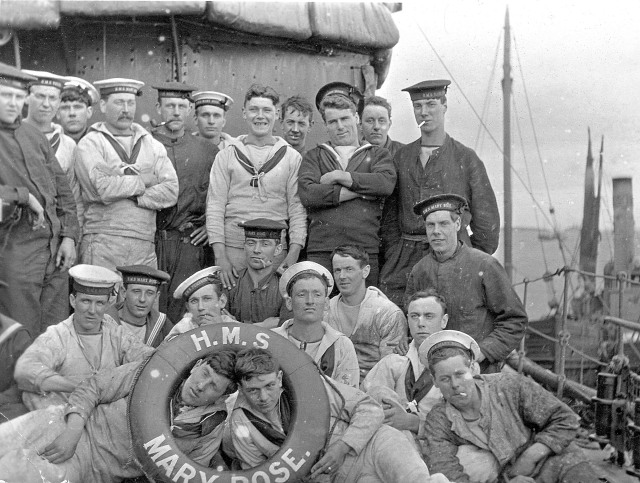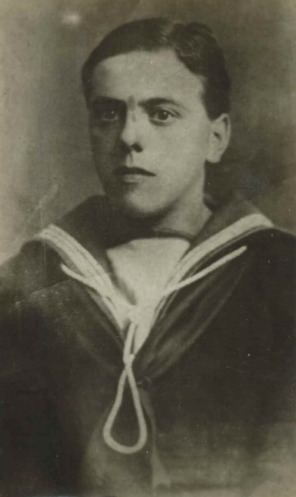
One hundred and one years ago today, Joe Deverill’s ship went down in the North Sea. He was on board HMS Mary Rose, with 100 or so other men, when they were attacked by two German light cruisers in the early hours of the morning. Mary Rose and her sister ship Strongbow were destroyers charged with accompanying a convoy of merchant ships back and forth between Scotland and Norway — the job was usually boring, according to one of the sailors who survived, and who called the trips “mail runs.” But October 17, 1917, was the opposite of boring. The convoy was sunk, and some 250 men lost their lives.

Joe’s story was only a tiny footnote in our larger story when my sister Tracy and I began the research for The Cowkeeper’s Wish. Little did we know that we would end up in the National Archives in London, meeting with other descendants of Mary Rose men, and scouring court documents, reading the actual testimony of the men who survived this terrifying ordeal. On the Mary Rose, those men were few in number. Only 10 made it safely to Norway, having witnessed the horrible deaths of their shipmates.
It was fascinating work finding out about these men — those who perished and those who survived — and gathering them into a “community” on the Imperial War Museum’s wonderful site, Lives of the First World War. That’s where our research began, and it grew massively from there. Service records, newspaper accounts, family lore, photographs, letters, and testimonies from the survivors all combined to give us stunning details, some tiny, some rich, that helped us revive the men’s stories: one sailor had a “True Love for Maggie” tattoo, and another had webbed toes; a survivor confessed in a letter to another man’s widow that he would “go sick” if he were sent to sea again after “that horrible massacre”; another widow had a baby not long after her husband was killed, and named the child Mary Rose; a 17-year-old midshipman had only just been temporarily transferred to the Mary Rose, and was meant to go back to his own ship in a week’s time; yet another man — a survivor whose identity we haven’t uncovered — brought a piece of Mary Rose wreckage to a deceased man’s family when he came to offer his condolences and tell them what had happened. How difficult and necessary such visits must have been, not just after this event, but after so many of the tragedies of war.
It could have been Joe who made the offering, for a family story exists that he did visit a friend’s mother to offer what news he could about her dead son. He himself had survived — but the joy of being alive was surely muted by loss. Just 19 when the attack occurred, Joe was carrying a lucky penny that exists to this day, and features on the cover of The Cowkeeper’s Wish.
One hundred and one years later, we can’t know all that happened that day, and what it did to the men and their loved ones. But the book contains as full an account as we could manage of this small episode of WW1. Here is the opening of the chapter “Down-Hearted and Shivery,” which recounts the attack and its aftermath:
As the news of Mary Anne’s death travelled toward him that October in 1917, Joe unwittingly moved farther away from it. On the morning of the 15th, Mary Rose and her sister destroyer Strongbow left Lerwick, accompanying a convoy of merchant ships to Norway with the help of two British fishing trawlers fitted out for escort purposes. The trips were sometimes boring, as Joe’s crewmate John Bailey had noted, but also potentially dangerous. The convoy system hadn’t been perfected yet, and many of the merchant ships, or “packets” as they were known, had little experience travelling in such a regimented way. Sometimes the fast ships pushed too far ahead, and the slower ships lagged behind, making the destroyers’ job to guard the whole group not just challenging but maddening because of all that could go wrong while the gaps in the convoy widened. Sometimes, too, the destroyers were purposely sent in different directions. By the morning of the 16th, after an uneventful sail, Mary Rose and Strongbow were approaching Norway with their group. As per their instructions on leaving Scotland the day before, they parted ways when they encountered a second westbound convoy. Mary Rose took up this new convoy of twelve ships, and with the trawler P. Fannon started back toward Lerwick. Strongbow, with the trawler Elise, carried on with her original charges. Once she’d seen them to shore at Bergen, Norway, she would turn back and rejoin the westbound group.
Evening had come by the time Strongbow and Elise drew close to the others again. Several times through the night, Strongbow’s Lieutenant-Commander Edward Brooke attempted to reach Charles Fox on Mary Rose but was unable to make contact. Fox, for his part, did not know that Strongbow had returned, but he zigzagged ahead anyway, staying close to a couple of the faster ships in the convoy and drawing farther away from the bulk of the packets lagging behind. With Lerwick in reach, the convoy grew uneven. By dawn the two destroyers were close to ten miles apart with most of the merchant ships between them. The sky was lightening but cloudy, and the sea was rough. Just before six, Strongbow’s officer of the watch sighted two ships coming closer. He assumed, from their dark grey colour, that they were British light cruisers. But when Strongbow flashed its recognition signals, the ships answered by opening fire.
♦
With thanks to Sue Church for her diligence and enthusiasm researching the Mary Rose, and for bringing so many of the crew’s descendants together.



Such incredible stories! Thank you for sharing!!
xo s
LikeLiked by 1 person
Thank you!
LikeLike
What a life altering event and at such a young age! My son Alexander, is now nineteen so that really gives me perspective on Joe’s age at the time of the attack. I like to think that indeed, it was Joe who visited the mother of his deceased comrade. Strangely, I think it may have been a comfort of sorts for her to speak with Joe, a bridge between her son’s last moments and the brave storyteller standing before her.
LikeLiked by 1 person
I think you’re right Michele. I think many people desperately wanted information. It was quite moving to read several letters (held by the IWM) written by the men who’d survived. The widow they wrote to had obviously asked them to offer their accounts of anything they knew of her husband’s last moments. I’m sure there were many such cases. I can only imagine how such an exchange would unfold in person.
LikeLike
Great story.
LikeLiked by 1 person
Thanks! And thanks for following…
LikeLiked by 1 person
It is hard to imagine this harrowing experience at all, let alone at 19. And the heartwarming stories that followed are testament to how these men and their families coped and survived to enable life to move forward and remember, as hard as that must have been at the time. The little girl named Mary Rose and the holder of the penny – both symbols and keepers of the past and hope for the future.
LikeLiked by 2 people
Oh yes, beautifully said.
LikeLike
Pingback: Uncovering the cover – The Cowkeeper's Wish
I have just discovered your amazing book. Thank you. For me personally so many heartfelt stories, one of hope for many but sadness for all.
Albert French is my great grandfather and reading today brought a sense of understanding but also great sadness. Thank you for sharing.
LikeLiked by 1 person
Hi Mark. Thanks so much for your comment. The Mary Rose story is such a tragic one, isn’t it? We spent many hours researching what happened when the ship was sunk, and trying to find out more about the men on board. So many lives lost. We sometimes encountered other descendants of these men, doing the same research, which added a whole new layer to our work. Very pleased to receive your message, and to know the story resonated with you.
LikeLike